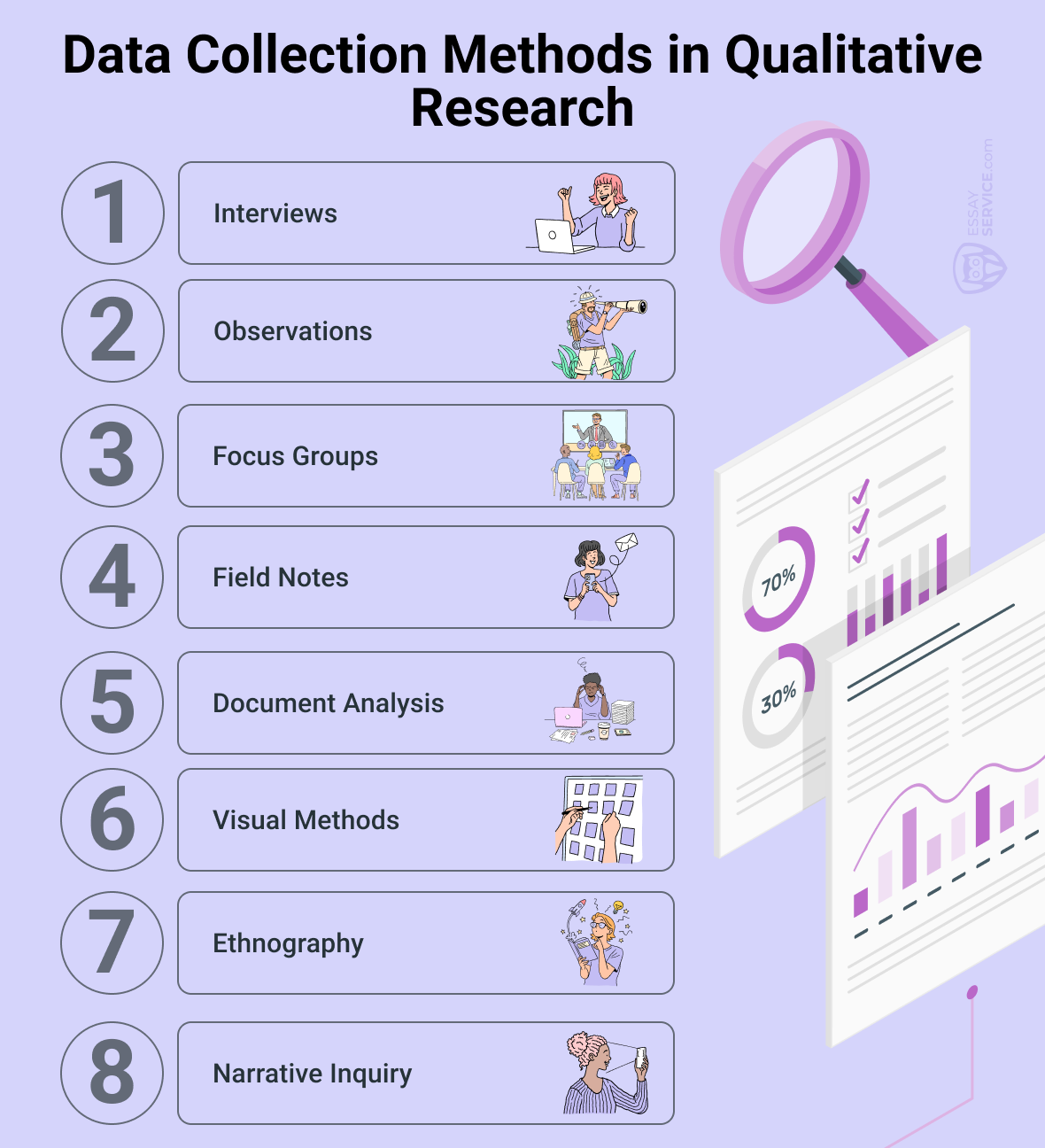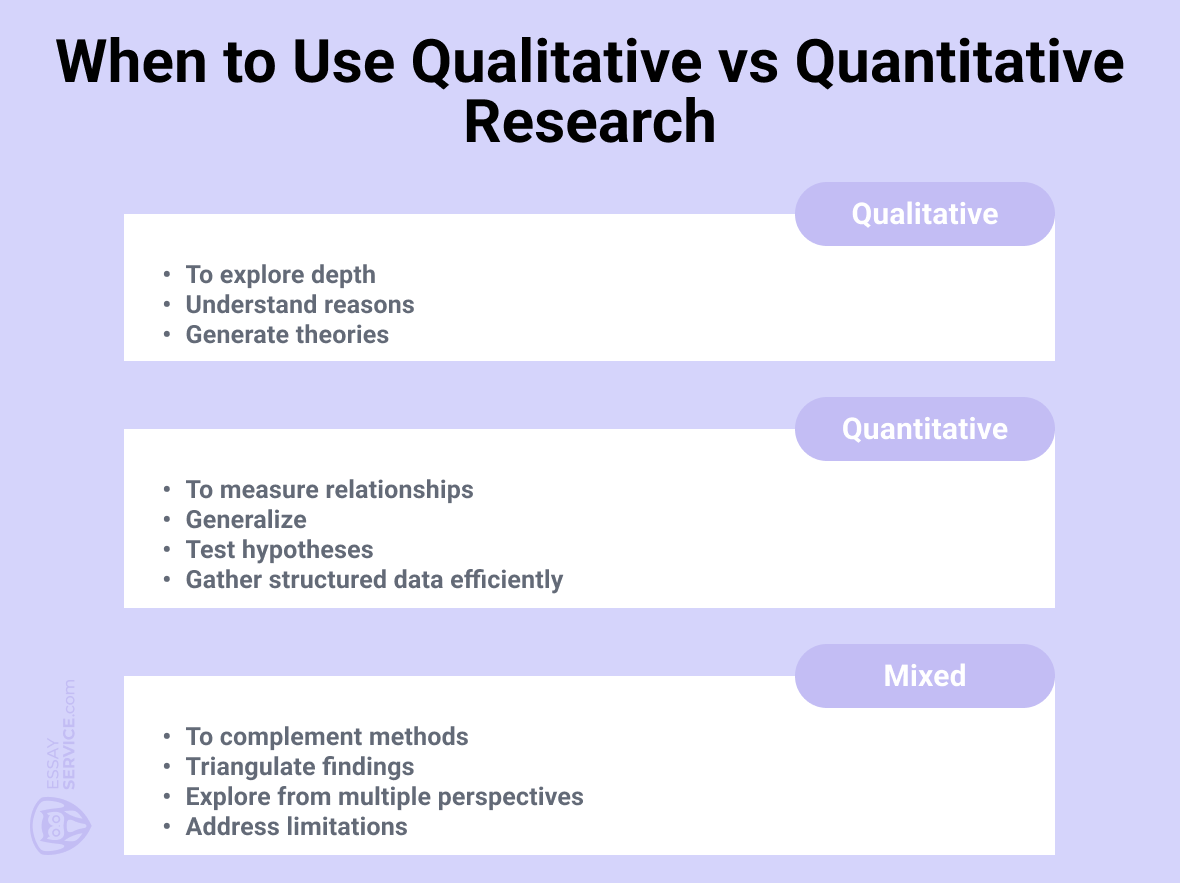
Qualitative vs Quantitative Research - Differences Uncovered
Many undertaking research projects often blur the lines between Qualitative and Quantitative Research, assuming they're interchangeable. Yet, your study likely falls into one or both categories.
Qualitative Research deals with open-ended feedback, resisting statistical analysis, while Quantitative Research thrives on precise, quantifiable data, making it a breeze to analyze through surveys.
With this clarity, let's delve deeper. In this article, we'll unpack qualitative vs quantitative goals: what they are, how they're applied, their strengths and weaknesses, and when to opt for one over the other.
What Is the Difference between Qualitative and Quantitative?
Qualitative and quantitative research methods differ in how they collect and analyze data. Qualitative relies on methods like interviews and observations to explore subjective experiences, while quantitative uses surveys and experiments to gather numerical data.
The data collected in qualitative research are personal accounts, aiming to understand human behavior in society, while quantitative deals with measurable data to establish relationships between variables.
These methods lead to different outcomes. Qualitative research provides detailed descriptions of human experiences, revealing themes and contexts. Quantitative research, however, produces numerical data analyzed statistically to identify patterns and make predictions for the larger population.
These differences show the special strengths and weaknesses of each method, which affect how study turns out. Now, let's explain the difference between qualitative and quantitative data collection methods, covering their types, advantages, disadvantages, and more below.
What Is Qualitative Research?
Qualitative research is a method of inquiry used to understand and interpret social phenomena in their natural settings. Unlike quantitative, which focuses on numerical data and statistical analysis, qualitative emphasizes exploring subjective experiences, meanings, and perspectives.
In qualitative research, data collection methods typically include interviews, observations, focus groups, and document analysis, allowing researchers to gather rich and detailed data on participants' experiences. We'll explain the quantitative observation meaning and go deeper in each method in the sections below.
One of the key characteristics of qualitative research is its interpretive nature. Researchers actively engage with the data, interpreting meanings and patterns within the context of the study topic. This interpretive approach acknowledges the role of the researcher's subjectivity and encourages reflexivity throughout the research process. Qualitative methods are used across various disciplines, including:
- sociology
- anthropology
- psychology
- education
- history
Types of Qualitative Research
- Phenomenological Research aims to explore how individuals experience and make sense of particular phenomena. Researchers seek to understand the essence of lived experiences by examining participants' subjective perspectives and interpretations.
- Grounded Theory is a systematic methodology for developing theories based on empirical data. Researchers collect and analyze data to identify patterns and concepts, which are then used to develop theoretical frameworks grounded in the data.
- Ethnographic Research involves immersive, long-term engagement with a particular social group or culture. Researchers observe and participate in daily activities, rituals, and interactions within the community to gain a deep understanding of its cultural norms, practices, and meanings.
- Case Study Research focuses on the in-depth exploration of a single case or a small number of cases. Researchers gather detailed data through multiple methods, such as interviews, observations, and document analysis, to provide a comprehensive understanding of the case under study.
Data Collection Methods in Qualitative Research
Here are some of the most frequently used qualitative data collection methods:
- Interviews: Engage participants to explore experiences and beliefs. It can be structured, semi-structured, or unstructured.
- Observations: Record behaviors and interactions for firsthand exploration of social dynamics.
- Focus Groups: Discuss specific topics in small groups, encouraging interaction and diverse opinions.
- Field Notes: Capture real-time observations to aid analysis during interviews or observations.
- Document Analysis: Examine existing texts or artifacts for insights.
- Visual Methods: Use visual stimuli for enhanced understanding beyond verbal communication.
- Ethnography: Immerse in a community for deep cultural understanding through long-term engagement.
- Narrative Inquiry: Analyze personal stories to understand experiences and identities.

Advantages and Disadvantages of Qualitative Research
Pros:
- Qualitative research explores complex phenomena deeply.
- Allows adaptation of methods based on emerging insights.
- Generates detailed accounts of participants' experiences.
- Offers insights into social and cultural factors.
Cons:
- Susceptible to researcher bias and interpretation variations.
- Findings are often specific to context and sample.
- Requires extensive engagement and analysis.
- Challenging to replicate, affecting reliability.

What Is Quantitative Research?
The meaning of quantitative observation involves collecting data as numbers or values, aiming for objectivity. In contrast, qualitative research describes things using non-numerical terms like appearance or texture.
To gather data, quantitative research uses surveys, experiments, observations, and analyzing existing information. A key characteristic is its focus on objectivity and replicability. Researchers work to minimize bias and subjectivity, using standardized procedures and statistical techniques to ensure reliable findings. Its findings aim for generalizability across contexts, making it valuable in fields like:
- psychology
- sociology
- demography
- marketing
- gender studies
- political science
Types of Quantitative Research
- Descriptive research aims to describe and summarize the characteristics of a population or phenomenon. It involves collecting data through surveys, observations, or existing records and using descriptive statistics to analyze and present the findings.
- Correlational research examines the relationship between two or more variables without manipulating them. Researchers use correlational analysis to determine the strength and direction of associations between variables but cannot establish causality.
- Experimental research involves manipulating one or more variables to determine their effect on another variable. Researchers use experimental designs, such as randomized controlled trials, to establish cause-and-effect relationships between variables.
- Longitudinal research follows the same individuals or groups over an extended period to study changes or developments over time. Researchers collect data at multiple time points and analyze trends and patterns in behavior or outcomes.
- Quasi-experimental research resembles experimental research but lacks full experimental control. Researchers manipulate independent variables and observe their effects on dependent variables but cannot randomly assign participants to conditions.
Data Collection Methods in Quantitative Research
Let’s examine quantitative data collection methods in research:
- Surveys: Standardized questionnaires collect data efficiently from diverse populations.
- Experiments: Manipulate variables to establish cause-and-effect relationships.
- Structured Observations: Systematically record predefined behaviors in controlled settings.
- Secondary Data Analysis: Analyze existing datasets for research purposes.
- Psychometric Tests: Measure psychological constructs with validated instruments.
- Biometric Measurements: Use physiological indicators for quantitative data collection.
- Content Analysis: Systematically analyze textual or visual content for patterns.
- Online Analytics: Collect and analyze digital data from online sources.

Advantages and Disadvantages of Quantitative Research
Pros:
- Quantitative research focuses on numerical data, reducing researcher bias.
- Findings can often apply to larger populations.
- Allows rigorous identification of patterns and relationships.
- Gathers data from large samples quickly.
Cons:
- May overlook contextual nuances.
- Doesn't always explain underlying reasons.
- Limits flexibility to explore emerging phenomena.
- May overlook qualitative aspects of the topic.
What Is Mixed Methods Research?
Mixed methods research offers a powerful strategy by blending qualitative and quantitative methods, leveraging the best of both worlds. Qualitative data offers depth, allowing researchers to explore phenomena, generate hypotheses, and grasp complexities. Quantitative data then rigorously tests these hypotheses, enabling the drawing of generalizable conclusions applicable to broader populations.
Essentially, when addressing certain research questions, a combination of both methods proves invaluable. Open-ended inquiries afford insights into various perspectives and experiences, while quantitative research provides the means to validate or refute hypotheses, adding a layer of empirical rigor to the findings.
When to Use Qualitative vs Quantitative Research?
Deciding between these research methods can be crucial for the success of your study. Understanding the difference between qualitative and quantitative data and when to use each approach is key to obtaining accurate and insightful results. Let's explore when it's best to employ qualitative, quantitative, or a combination of both methods.

Use Qualitative Research When
- You want to explore complex phenomena in depth, understanding the reasons behind certain behaviors or attitudes.
- You aim to uncover insights into people's experiences, emotions, and perspectives.
- You're in the early stages of research and need to generate hypotheses or theories.
- You're studying sensitive topics where open-ended discussions are more appropriate.
Example: You're studying the effects of a new educational program on student motivation and engagement. Qualitative research would be valuable for gathering in-depth insights through interviews and observations and understanding the nuances of how students perceive and interact with the program.
Use Quantitative Research When
- You need to measure and quantify data to establish relationships between variables.
- You want to generalize findings to a larger population.
- You aim to test hypotheses or validate theories through statistical analysis.
- You need to gather structured data efficiently from a large sample size.
Example: You're conducting a health study to determine the prevalence of a certain disease in a population. Quantitative methods, such as large-scale surveys or medical records analysis, would provide statistical data to estimate disease rates and risk factors.
Use Mixed Research When
- You want to complement the strengths of qualitative and quantitative methods to gain a comprehensive understanding of a research topic.
- You need to triangulate findings from different data sources to enhance the validity of your results.
- You want to explore a research question from multiple perspectives, combining both qualitative and quantitative data.
- You aim to address the limitations of one method with the strengths of another, providing a more robust analysis.
Example: You're evaluating a workplace training program's effectiveness. By combining qualitative interviews with participants to understand their experiences and quantitative surveys to measure changes in knowledge and skills, you can gain a comprehensive view of the program's impact.
Summing Up
In essence, while qualitative vs quantitative research may sound alike, they're distinct methods with unique strengths. Rather than an either/or scenario, combining both offers profound insights into your audience.
By appreciating the difference between qualitative and quantitative research and selecting the most suitable approach for your goals, you can conduct insightful studies that enrich our understanding of the world. Fortunately, choosing the right method doesn't have to be daunting with our custom research paper service, which is always at your service.
Frequently asked questions
What Is the Difference between Qualitative and Quantitative Research Methods?
Qualitative research focuses on understanding people's behaviors, beliefs, experiences, and interactions through methods like interviews, observations, and analysis of texts. It delves deep into the meaning behind phenomena, often generating rich, descriptive data. Quantitative research, on the other hand, deals with numbers and measurable data, aiming to quantify relationships, patterns, and trends. It typically involves surveys, experiments, and statistical analysis to draw conclusions based on numerical data.
What Are 5 Examples of Quantitative Research Paper?
Quantitative research papers employ numerical data and statistical analysis to investigate research questions. Examples include:
- A study on the effects of sleep duration on academic performance.
- Study examining the relationship between exercise frequency and heart health.
- An investigation into the impact of social media usage on teenagers' mental well-being.
- A survey analyzing consumer preferences for smartphone brands.
- A study exploring the correlation between income level and access to healthcare services.
Why Is Qualitative Research Important?
Qualitative research helps us understand people's perspectives and behaviors in depth. It's great for exploring complex topics where numbers alone might not tell the full story. Qualitative research can uncover new insights and ideas that quantitative methods might miss. It's often used to inform the development of products, services, and policies by getting to the heart of what people really need and want. Plus, it's a powerful tool for giving a voice to marginalized or underrepresented groups.
- added new FAQs;
- all the sections were rewritten with new information.
New posts to your inbox!
Your submission has been received!



